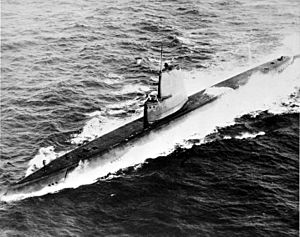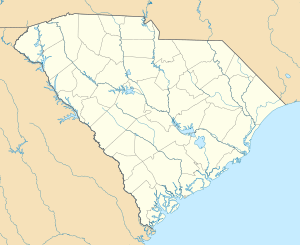USS Clamagore facts for kids

USS Clamagore (SS-343), after its GUPPY upgrade
|
|
Quick facts for kids History |
|
|---|---|
| Name | Clamagore |
| Namesake | Clamagore |
| Builder | Electric Boat Company, Groton, Connecticut |
| Laid down | 16 March 1944 |
| Launched | 25 February 1945 |
| Sponsored by | Miss M. J. Jacobs |
| Commissioned | 28 June 1945 |
| Decommissioned | 12 June 1975 |
| Stricken | 27 June 1975 |
| Fate | Scrapped, 2022 |
| Badge |  |
| General characteristics (World War II) | |
| Class and type | Balao-class diesel-electric submarine |
| Displacement | |
| Length | 311 ft 9 in (95.0 m) |
| Beam | 27 ft 3 in (8.3 m) |
| Draft | 16 ft 10 in (5.1 m) maximum |
| Propulsion |
|
| Speed |
|
| Range | 11,000 nmi (20,000 km; 13,000 mi) surfaced at 10 kn (19 km/h; 12 mph) |
| Endurance |
|
| Test depth | 400 ft (122 m) |
| Complement | 10 officers, 70–71 enlisted |
| Armament |
|
| General characteristics (Guppy II) | |
| Displacement |
|
| Length | 307 ft (93.6 m) |
| Beam | 27 ft 4 in (8.3 m) |
| Draft | 17 ft (5.2 m) |
| Propulsion |
|
| Speed |
|
| Range | 15,000 nmi (28,000 km; 17,000 mi) surfaced at 11 kn (20 km/h; 13 mph) |
| Endurance | 48 hours at 4 kn (7.4 km/h; 4.6 mph) submerged |
| Complement |
|
| Sensors and processing systems |
|
| Armament |
|
| General characteristics (Guppy III) | |
| Displacement |
|
| Length | 321 ft (98 m) |
| Speed |
|
| Range | 15,900 nmi (29,400 km; 18,300 mi) surfaced at 8.5 kn (15.7 km/h; 9.8 mph) |
| Endurance | 36 hours at 3 kn (5.6 km/h; 3.5 mph) submerged |
| Complement |
|
| Sensors and processing systems |
|
|
USS Clamagore (Submarine)
|
|
| Location | Patriot's Point, Mt. Pleasant, South Carolina |
| Built | 1963 |
| Architect | Electric Boat Works |
| NRHP reference No. | 89001229 |
| Significant dates | |
| Added to NRHP | 29 June 1989 |
| Designated NHL | 29 June 1989 |
| Delisted NHL | September 2, 2024 |
The USS Clamagore (SS-343) was a submarine that served in the United States Navy. It was named after the clamagore. This submarine was special because it was the last one of its kind, a GUPPY III type, to still exist.
After its time in the Navy, the Clamagore became a museum ship at the Patriot's Point Naval & Maritime Museum in Charleston, South Carolina. It was there from 1979 until 2022. Sadly, in October 2022, the Clamagore was taken apart and recycled.
Contents
Building the Clamagore
The Clamagore was built by the Electric Boat Co. in Groton, Connecticut. Construction happened near the end of World War II. The submarine was officially launched on February 25, 1945. Miss Mary Jane Jacobs, whose father was Vice Admiral Randall Jacobs, was the sponsor. The Clamagore joined the Navy on June 28, 1945.
Early Missions and Upgrades
The Clamagore first went to Key West, Florida, in September 1945. It worked with other Navy ships and a special sonar school. Sometimes, it traveled to Cuba and the Virgin Islands.
In 1947, the submarine went to the Philadelphia Naval Shipyard. There, it received a big upgrade called GUPPY II modernization. This included adding a snorkel, which lets the submarine run its diesel engines underwater.
Years of Service and Travel
After its upgrade, the Clamagore returned to Key West in 1948. For the next eight years, it operated in the local area and the Caribbean Sea. It even went on a mission to the Mediterranean Sea in 1953.
In 1957, the submarine visited New London, Connecticut, and Newport, Rhode Island. Later that year, it joined NATO exercises in the North Atlantic. During these exercises, it stopped in Portsmouth, England, and Naval Station Argentia, Newfoundland.
In 1959, the Clamagore moved to its new home port in Charleston. The next year, it sailed to the Mediterranean again to join the 6th Fleet. It returned to Charleston in July 1960 and continued to operate off the east coast.
The GUPPY III Transformation
In 1962, the Clamagore was one of only nine submarines to get another major upgrade. This was called the GUPPY III conversion.
During this upgrade, the submarine's body was made longer by about 15 ft (4.6 m). It also got a new plastic sail (the tower on top). A special sonar system called BQG-4 PUFFS was added. This system helped the submarine find other ships underwater. You could see its three "sharkfin" sensors on the deck.
The Clamagore finished its GUPPY III upgrade in February 1963. It then moved to Submarine Squadron 2 (SUBRON2) in Groton, Connecticut.
Becoming a Museum Ship
The Clamagore was officially taken out of Navy service on June 12, 1975. It had served for thirty years. In 1979, it was given to a museum.
In May 1981, the Clamagore arrived at Patriot's Point Naval & Maritime Museum in Charleston, South Carolina. It was docked there as a museum ship. Other famous ships like the aircraft carrier Yorktown and the destroyer Laffey were also at the museum.
A National Treasure
On June 29, 1989, the Clamagore was recognized as a National Historic Landmark. This means it was a very important part of American history. It was special because it was the only GUPPY III type submarine left in the United States. These GUPPY submarines were a big part of the Navy's underwater fleet for many years after World War II.
The End of an Era
Over time, the Clamagore's hull (its outer body) started to wear out badly. The museum tried to find ways to save it. There were ideas to sink it as an artificial reef. However, the cost to fix and preserve the submarine became too high.
In the summer of 2022, the museum began the process of taking the Clamagore apart. Its National Historic Landmark status was removed in September 2024.
Awards and Honors
- Meritorious Unit Commendation
- Navy Expeditionary Medal
- American Campaign Medal
- World War II Victory Medal
- Navy Occupation Medal with "EUROPE" clasp
- National Defense Service Medal with star
Images for kids
See also





